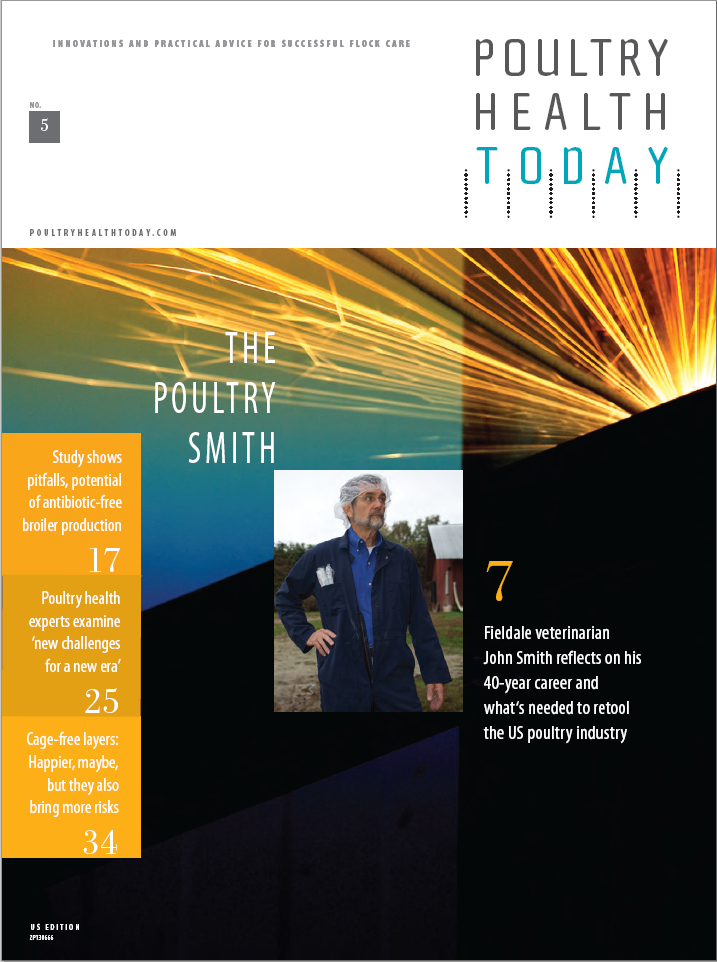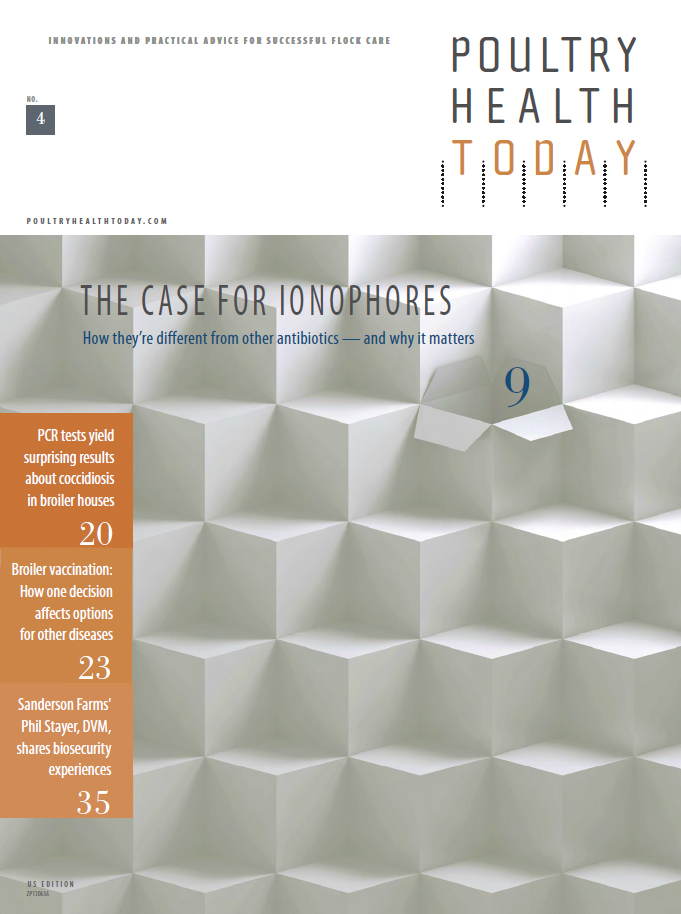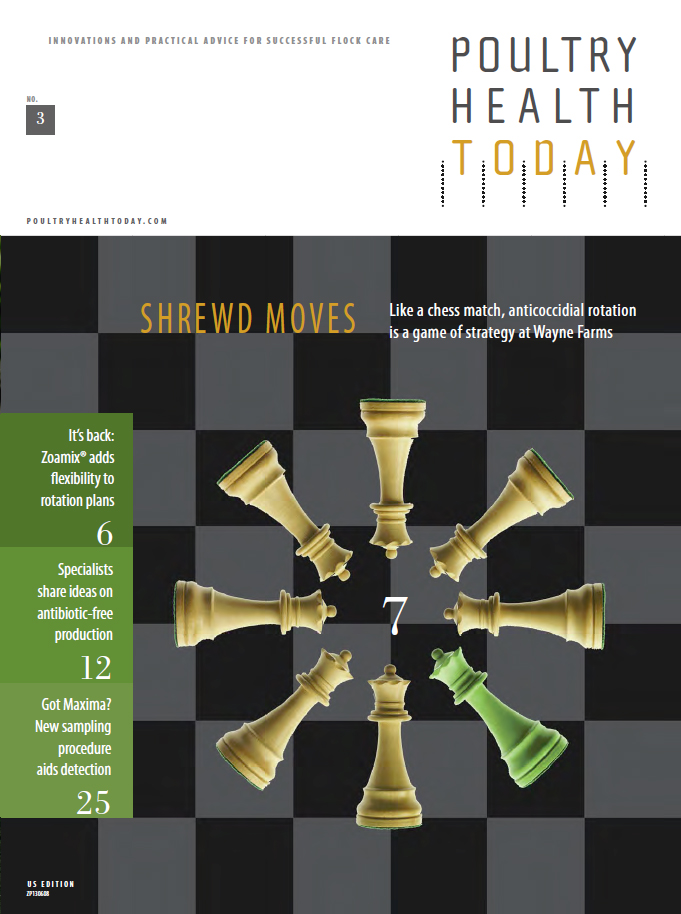

Raising Poultry Without Antibiotics

Meeting the challenge while maintaining flock health, welfare and sustainability
The US poultry industry has responded quickly to growing consumer demand for birds raised without antibiotics.
The trend has created several production challenges — most notably, increased pressure from enteric diseases, the need for lower bird density, declines in feed efficiency and higher production costs. Questions have also been raised about the practice’s long-term sustainability.
To help the industry address these issues, Zoetis Inc. organized a roundtable discussion featuring poultry experts, pioneers in antibiotic-free production and opinion leaders to share their experiences and offer insights on this emerging trend.
For more on the roundtable and a copy of the proceedings booklet, contact your Zoetis representative or watch for it on poultryhealthtoday.com
[Note: Two production veterinarians from major US poultry companies participated in the roundtable with the understanding that their names and affiliations would be withheld in published reports. They are identified here as Practitioner 1 and Practitioner 2 .]
Antibiotic-free poultry production remains uncharted territory that’s yielding varied results, a few surprises and an ethical dilemma for veterinarians, poultry experts said at an industry roundtable held in July 2014.
The biggest stumbling block in antibiotic-free (ABF) systems is preventing necrotic enteritis (NE) without the use of in-feed medications, panelists said at the roundtable, “Raising Poultry Without Antibiotics: Meeting the challenge while maintaining flock health, welfare and sustainability.”

Suzanne Dougherty, DVM, an independent poultry consultant based in Alabama, has been involved with ABF trials for the past 3 years. The results have varied with the geographic location, she reported, but overall, “it’s been a real challenge to find a program that doesn’t lead to NE issues.”
A production veterinarian speaking anonymously said the experience at his company has been similar. “We’re finding ABF birds do not perform as well as conventional flocks on feed conversion or livability, and we typically see NE to some degree in trials so far,” Practitioner 1 said.
Good Results
For another major poultry producer, however, ABF flock performance has been almost as good and, in some cases, has surpassed conventional flock performance, according to Practitioner 2, who also needed to remain anonymous.
“We thought our cost [for ABF flocks] in the long run might be 3 to 4 cents per live pound, but we got it down to 1.5 or 2 cents, which is pretty good,” he noted.

Stephen Shepard, a sustainability expert and director of poultry welfare and auditing at Farm Animal Care Training & Auditing, estimated the cost at about 2 to 3 cents per live pound.

The University of Georgia’s Charles Hofacre, DVM, PhD, said that on some farms ABF flocks start off well, but then “the wheels start to fall off” due to NE mortality.
He hasn’t been able to prove it, but he believes the problem is Eimeria, the cause of coccidiosis. As this parasite goes through its life cycle in the bird, it leads to a bacterial imbalance in the gut resulting in excess mucus, which feeds clostridia and leads to NE. Either the coccidia or clostridia build up after a few cycles, causing the ABF program to derail. To maintain success, it’s sometimes necessary to move the ABF operation to a new location, off the farm that’s having problems, he said.
Careful management essential

When roundtable moderator Tim Cummings, DVM, PhD, Zoetis, urged panelists to pinpoint keys to success for ABF production, they emphasized that careful attention to flock management is essential.
Although his company’s ABF program is new and doesn’t include an entire complex, Practitioner 2 credited two factors for the early success. First, the company always starts ABF flocks with a “new, clean slate,” including fresh litter, and it adheres to the Global Animal Partnership program, a five-step program for rating animal-welfare standards.
Dougherty said, when it comes to ABF birds, “It’s got to be back to basics. Brooding those first 7 to 10 days — whether it be density, clean litter, feed and water availability — all those things are critical.”
Diets must consist of high-quality ingredients. Consider the age of the corn since there is a higher risk that older corn will contain mold and mycotoxins, which can damage the gut and increase the risk for NE. Feed form and particle size are important too, she said. A coarser diet is better for ABF broilers, Practitioner 2 said. When it comes to feed form and particle size for ABF birds, “the bigger, the better.” His company also “dumbed down” the starter diet to include less protein since high protein has been associated with the development of NE.

Steve Davis, DVM, of Colorado Quality Research, said, “There’s no doubt that high protein in the diet can definitely have an adverse impact.” But he doesn’t think it’s simply due to gut irritation caused by animal byproducts. “I think poor-quality animal byproducts are actually a good source of clostridium,” the pathogen linked to NE.
Managing NE
Davis defines high protein as levels above 20% to 22% and says this can greatly increase the incidence and severity of an NE outbreak. “It appears that getting broilers on grower feed that’s 18% or lower before they hit the critical age of 17 days reduces the incidence and severity of NE that can be produced in models.”
Dougherty added, “Most producers raising ABF flocks have had to switch to an all-vegetable diet with no animal protein, which is less likely to contain clostridium and other bacteria.”
Pulling animal protein reduces the likelihood of clostridial contamination and spores in the feed.
Hofacre agreed that diet is key in ABF production and said he has also noted a move away from animal byproducts toward an all-vegetable diet for ABF flocks.
Practitioner 1 added that it’s especially important with ABF flocks to have good ventilation and to keep litter moisture to a minimum, while Davis said his research indicates that one way to help decrease NE mortality is by warming birds to slow feed consumption. “It’s like the heavier they are, the harder they fall.”
No silver bullet
The panelists shared their experiences with alternative products for managing NE, such as essential oils, acidifiers or probiotics.

Greg Mathis, PhD, founder of Southern Poultry Research in Georgia, said that in some cases these products “just aren’t going to do it.” They may perform well in a trial, he added, but they don’t in the field where there are more variables.
Davis said, “Everyone is trying to find the silver bullet, but it doesn’t exist.” In fact, in his experience, there are more alternative products that make NE worse than there are alternatives that make it better.
He and Hofacre pointed out that clostridia that cause NE can vary significantly from farm to farm; an alternative product might modify gut flora and look good in a challenge study but just won’t work the way an antibiotic does.
One exception is enzymes, which have been shown to benefit ABF flocks on all-vegetable diets. In these situations, Davis explained, nutrients are not highly digestible by the bird but are digestible by bacteria. Enzymes can increase the digestibility of nutrients so they don’t get farther down into the intestines, toward the ceca, and change gut flora to an environment that’s favorable to clostridia and the development of NE, he explained.
Coccidiosis management
Experience with coccidiosis and ABF flocks has differed just as it has with NE. While Mathis said he considers ABF production “synonymous with coccidiosis,” Dougherty said she has found the disease isn’t always the primary problem.
For coccidiosis management, the use of vaccines instead of synthetic anticoccidials, which are allowed in ABF production, has proved to be unpredictable. “Sometimes vaccines work fabulously, and sometimes they don’t,” Dougherty said, adding that more work needs to be done to ensure better vaccine application and uniformity. “We have a long way to go with vaccines in ABF production.”
Practitioner 1 said his company used coccidiosis vaccines in trials designed to mimic ABF production. Nearly every time, he added, flocks broke with NE, though in some cases it occurred in only one house on a six-house farm.
Mathis emphasized that for successful coccidiosis vaccination, product quality and vaccine application are important. “As you get closer to the vaccine’s expiration date, quality declines,” he said, noting that he would like to see higher levels of coccidial oocysts in vaccines.
“Vaccines are fine if all the birds get it. If you made sure every single bird were inoculated, you’d never have an issue with coccidiosis. But that’s not the way it is,” he said.
Mathis emphasized the importance of preserving synthetic anticoccidials, particularly in ABF production schemes that prohibit the use of ionophores. He expects nicarbazin to be around for a while despite his own reports of some slippage, which he attributed to sampling at the end of winter. Sampling in the fall likely would have produced better results, Mathis explained.
All the synthetic anticoccidials should be used sparingly, and, if new ones become available, their efficacy really needs to be protected by rotating products. “We screwed up with Clinacox [diclazuril],” which was overused by the US poultry industry when it was introduced in 2003. That led to resistance issues, he said.
"Vaccines are fine if all the birds get it. If you made sure every single bird were inoculated, you’d never have an issue with coccidiosis. But that’s not the way it is." Greg Mathis, DVM
Gangrenous dermatitis
One pleasant surprise with ABF production has been a decrease in gangrenous dermatitis, a disease that’s been a “non-issue” in ABF flocks, Dougherty said.
Davis, who has worked extensively with NE models, said, “It’s very interesting. I’ve never seen a broiler farm break with NE early, then break later with dermatitis.”
Hofacre likewise reported seeing less gangrenous dermatitis in ABF flocks, even in complexes that seemed prone to the problem. He suggested that a change in the intestinal microflora might explain the phenomenon.
Ethical dilemma
All panelists lamented the mandatory exclusion of ionophores from ABF programs. While ionophores are used solely for managing coccidiosis, a parasitic disease, they are still classified as antibiotics and, therefore, cannot be used in ABF programs.
“Grouping ionophores in with other antibiotics for ABF production was a terrible mistake,” Mathis said, adding that it is difficult to manage the disease effectively and ably without having them in a rotation. In addition, more pressure from coccidiosis makes birds more susceptible to NE.
“I never thought we’d surpass the Europeans in forgoing ionophores,” Practitioner 2 said, adding that they are still widely used in Europe even though the EU banned the use of other feed antibiotics in 2006. “That’s been a big surprise for me.”
The panel agreed that the trend toward ABF production was creating an ethical dilemma for veterinarians charged with ensuring the health and welfare of broiler flocks.
On one hand, they noted, veterinarians took an oath to “use [their] scientific knowledge and skills for the benefit of society through the protection of animal health and welfare, the prevention and relief of animal suffering, the conservation of animal resources, the promotion of public health, and the advancement of medical knowledge.” Yet, some poultry companies are asking their veterinarians not to use antibiotics that FDA has said are safe and effective. In particular, they were concerned that they cannot use animal-specific antibiotics that are not important to human medicine, such as ionophores and other antibiotics that help maintain good intestinal health in poultry.
Tough decisions
Raising flocks without ionophores, Practitioner 2 said, creates both animal-welfare and public-health issues.
“We know ionophores are safe, yet we’re not using them in ABF systems. When we choose not to use ionophores, we’re making a decision to let birds die. Let’s be frank about it,” he said.
Dougherty said it’s ironic that consumers who want ABF poultry are often the same people who insist on good animal welfare.
“There’s a big disconnect there about understanding what the removal of antibiotics from poultry production truly means,” she said. “It’s a real challenge to balance ABF with animal welfare.”
Davis called it “a dilemma driven by consumer ignorance.”
He added, “It’s a fact that organic and ABF birds have a higher incidence of pathogens such as Salmonella and Campylobacter… and a higher 7-day mortality. We’re actually producing a product that’s not as safe for people or as good for birds. It’s in direct conflict with the oath we’ve taken as veterinarians.
“If we were in the business of raising puppies and were allowing them to die, it would be easy to educate the public” and stop whatever practices were causing the deaths, he said.
Call for public education
Hofacre noted that activist groups “have taken control of messaging to consumers and we in animal agriculture have not done a good job responding.”
Other panelists said restaurants are driving the ABF movement, believing they can differentiate their product and attract more customers if they advertise their meats as “antibiotic-free,” said Practitioner 1.
“If it were the public or consumers who felt their health was truly at risk because of our use of antibiotics, that would be one thing,” he added. “But I feel like a lot of this [movement] comes from businesses — and it’s a business decision aimed at making more money. That’s my frustration.”
Asked by Cummings exactly how the poultry industry can get its message out, panelists offered several ideas.
Dougherty said more careful consideration needs to be given to the way poultry and poultry products are labeled and to terminology. For example, it’s well documented that some antibiotics improve intestinal health and thereby result in better feed conversion and growth rate. “In hindsight, calling some antibiotics ‘antibiotic growth promoters’ wasn’t the smartest thing to do,” Dougherty said, “and the public probably isn’t going to understand what the ‘judicious use’ of antibiotics means.”
Although they don’t have the money activists do to conduct campaigns, veterinarians are the best ones to deliver messages to the public about poultry production because they are one of the most respected and trusted professions, she said.
Davis suggested poultry veterinarians consider forming an organization devoted to promoting the welfare of chickens; Hofacre concurred but suggested adding poultry farmers to the group.
“To me, that’s the way to go,” the professor said. “Have young farmers go hand-in-hand with veterinarians to put a face on the poultry industry and get across the point that farmers want to take good care of their animals and don’t want them to die.”
Need specific guidelines
Hofacre thinks it would also be helpful if the American Veterinary Medical Association (AVMA) established a vehicle for countering activist marketing pressure. The AVMA could establish more specific guidelines about when to initiate antibiotic treatment, perhaps based on increased morbidity or mortality. “Then poultry producers could say to customers that they are following AVMA guidelines,” he said.
One panelist suggested a public-education campaign that has shock value by showing the consequences of removing antibiotics from poultry production. Pictures of sick chickens, for instance, might get the public’s attention and really make a difference.
Shepard urged the poultry industry to be more proactive and transparent on the antibiotic issue.
“I think the ball’s in our court and needs to start within poultry operations,” he said. Upon talking to poultry company employees,
There’s a big disconnect there about understanding what the removal of antibiotics from poultry production truly means. Suzanne Dougherty, DVM
it’s clear they have misconceptions just like many consumers; some mistakenly think chickens are raised with hormones and steroids.
The industry also needs to have a meaningful discussion with food vendors, Shepard said. To illustrate his point, he told of one retailer who called to ask how much cage space a certain broiler producer provided for its birds. When Shepard replied, “There are no cages,” the caller couldn’t believe it.
Hofacre said educating the media was equally important, adding that he recently met with an agriculture reporter who had never met a farmer.
“The poultry industry,” Shepard concluded, “needs to tell its own story and it needs a strategy now.”
More Issues












